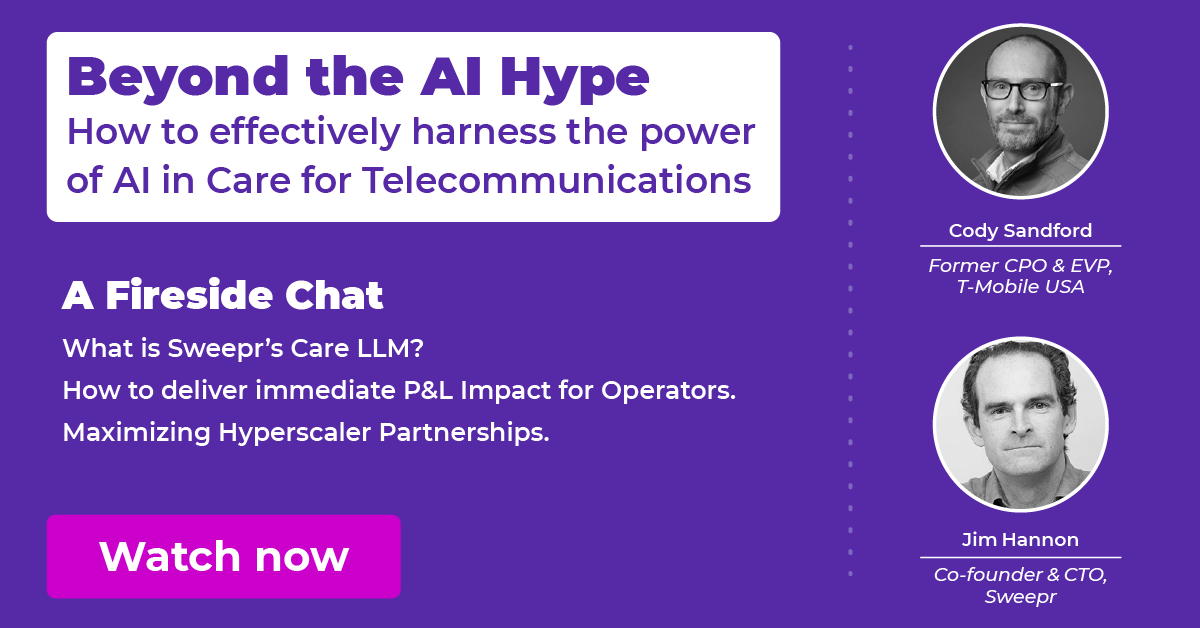At Sweepr, we’ve spent a fair while building out a platform to drive compelling customer interactions for digital care. Like every good start-up trying something big and audacious, we’ve been on quite a journey to develop our platform. Our goal was to build something that could link disparate systems across the cloud, internet and customers’ home environments to gather contextual data and use it to dynamically solve their issues through interactions that are meaningful and compelling. This would result in both retaining the customer as a user of digital care and driving positive ongoing sentiment towards digital care as a concept. It was a challenge, to say the least.
Our goal was to build something that could link disparate systems across the cloud, internet and customers’ home environments
Digital customer care needs to be applied over a wide range of experiences and a broad range of channels.
It’s important to me to validate our ideas with customers, researchers and, of course, VC investors. Whilst talking to a very seasoned VC investor the other day we talked about the art of the pivot. I said we were in some form of a pivot with “Sweepr 2.0”, but not the full change of business model that this implies. He retorted that the pivot was grossly misunderstood. Evolving in the tech sector is not about some “light bulb moment”, where you have ultimate clarity and the next year are Jeff Bezos – losing sleep over how to compete in the Billionaire Space race. It’s more of an educated shuffle around with your ears and eyes wide open until you find how to compete and how to differentiate, and finally rapid, effective execution when you find that critical product-market fit.
It’s important to me to validate our ideas with customers, researchers and, of course, VC investors.
Personalisation is Core to Successful Digital Engagement
Sweepr also embarked on a journey of evolution whilst researching the way in which we can support our customers in achieving their digital outcomes. At the core of our shuffle has been to see that digital engagement is central to any form of successful care transformation, we can be the smartest tool in the box but if the consumer won’t use it, who cares, being the magic 8 ball that’s used by 0.2% of humanity is a massive fail. That realisation even applies to proactive fixes. It’s great to make your customer’s home network better, kudos, but what impact if they have no idea you’ve been quietly working in the background to create a great experience? You need them engaged, to value your service and ultimately keep them a happy customer with strong NPS and long term, sticky revenue streams.
the magic 8 ball that’s used by 0.2% of humanity is a massive fail.
At Sweepr we believe hyperpersonalisation is at the core of this, along with support for multiple touchpoint Journeys and other key capabilities. Personalisation has been around in some shape or form for two decades or more – I’ve even co-founded and sold a company that had it at its centre – but more often than not it’s at a very trivial level to the extent that it has close to no value. It’s like the annoying chatbot with its completely obvious little persona-based tweaks to sound like it’s not a bot, when any sane human, cat or even dog could see it’s a bot, and a bot with very poor impact.
To have an impact, personalisation must have a meaningful memory of what the customer asked about before and how that went for them.
7 Principles of Personalisation
Our personalisation concept has seven core principles that hang off three pillars:
- The customer’s psychology and their behaviour during the interaction
- The context of the customer and their home network environment
- The relationship between the customer and the provider, and the previous queries they have asked
To have an impact, personalisation must have a meaningful memory of what the customer asked about before and how that went for them. It must unobtrusively pick up the aptitude, sentiment and circumstances of the customer at that point in time for digital care. It should use existing and inferred analytics of the customer profile to deliver a honed experience that’s relevant and likely to succeed and should use clustering and other segregation techniques to ensure we know something about the customer in the critical early first interactions.
Around the Whiteboard
Behind all this is a digital engagement platform that uses a highly scalable real-time analytics layer to gather, map, transform and aggregate data into insights. These insights are at the core of the 7 Principles of Personalisation and are carried along with diagnostic context data points to allow us to deliver the type of compelling experience our consumer base now expects, indeed insists upon.
The areas we’ve focused on for this gnarly problem are many and deep but some are key to success. We’re quite traditional at Sweepr, so our whiteboard looked a little like this:
We’re still advancing this area and have more of a road to travel (and many story points to burn) but I think we’re moving out of the pivot shuffle and starting into the steady jog, and I know from experience of the many startups I’ve hauled myself through this part is where the fun starts!
Book a tour to discover how Sweepr’s 7 Principles of Personalisation help CSPs hyperpersonalise digital customer care experiences.

